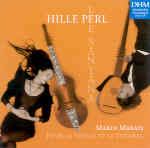I am not ordinarily a fan of the viola da gamba, particularly its lower register, which easily comes to sound like a dying cow. The French Baroque repertoire is especially vulnerable to “mad cow syndrome” as a result of its frequent invitation for performers to indulge in wild extremes of affectation and exaggeration. Reading contemporary descriptions of the sound of the instrument and its theoretically exquisite shades of tone, and then hearing the often grotty scratch and scrape of so many of today’s highly acclaimed period-instrument specialists, I can well understand many listeners questioning what all of the fuss is about.
The new release goes a long way toward answering that question. Marin Marais actually published only a single piece for gamba and theorbo. The music included here was taken from a Scottish manuscript in the composer’s hand consisting of early versions of works later revised and published in the larger collections–but that’s no disadvantage. Quite the opposite. Perhaps the presence of the theorbo (as opposed to a heavier continuo contingent) permits Hille Perl to play with greater tenderness and prevents her tone from sounding like she’s sharpening a rusty sword on a whetstone; or maybe it’s the sweet and dusky timbre of her instrument. But whatever the reasons, this is just lovely, mellifluous music-making of great style and charm.
There are many memorable moments, most notably the gorgeous Rondeau Louré from the Suite in G. Even more impressive is the way that Perl and Lee Santana sustain the big pieces: Folies and the Chaconne from the two suites in D, and the concluding Sujet Diversitez. In all of these cases, careful attention to the long, singing line makes a mockery of the “hack and chop” approach so often heard in this music. Perfect balances, an absolute minimum of performance noises from Santana, and luminous recorded sound top off a truly distinctive recording that deserves attention well beyond the usual crowd of French Baroque specialists. [7/12/2004]
































